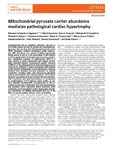Mostrar o rexistro simple do ítem
Mitochondrial Pyruvate Carrier Abundance Mediates Pathological Cardiac Hypertrophy
| dc.contributor.author | Fernández-Caggiano, Mariana | |
| dc.contributor.author | Kamynina, Alisa | |
| dc.contributor.author | Francois, Asvi A. | |
| dc.contributor.author | Prysyazhna, Oleksandra | |
| dc.contributor.author | Eykyn, Thomas R. | |
| dc.contributor.author | Krasemann, Susanne | |
| dc.contributor.author | Crespo-Leiro, María Generosa | |
| dc.contributor.author | García-Vieites, M. | |
| dc.contributor.author | Bianchi, Katiuscia | |
| dc.contributor.author | Morales, Valle | |
| dc.contributor.author | Doménech, Nieves | |
| dc.contributor.author | Eaton, Philip | |
| dc.date.accessioned | 2021-03-25T13:13:39Z | |
| dc.date.issued | 2020-10-26 | |
| dc.identifier.citation | Fernandez-Caggiano M, Kamynina A, Francois AA, et al. Mitochondrial pyruvate carrier abundance mediates pathological cardiac hypertrophy. Nat Metab. 2020; 2:1223–1231 | es_ES |
| dc.identifier.issn | 2522-5812 | |
| dc.identifier.uri | http://hdl.handle.net/2183/27599 | |
| dc.description.abstract | [Abstract] Cardiomyocytes rely on metabolic substrates, not only to fuel cardiac output, but also for growth and remodelling during stress. Here we show that mitochondrial pyruvate carrier (MPC) abundance mediates pathological cardiac hypertrophy. MPC abundance was reduced in failing hypertrophic human hearts, as well as in the myocardium of mice induced to fail by angiotensin II or through transverse aortic constriction. Constitutive knockout of cardiomyocyte MPC1/2 in mice resulted in cardiac hypertrophy and reduced survival, while tamoxifen-induced cardiomyocyte-specific reduction of MPC1/2 to the attenuated levels observed during pressure overload was sufficient to induce hypertrophy with impaired cardiac function. Failing hearts from cardiomyocyte-restricted knockout mice displayed increased abundance of anabolic metabolites, including amino acids and pentose phosphate pathway intermediates and reducing cofactors. These hearts showed a concomitant decrease in carbon flux into mitochondrial tricarboxylic acid cycle intermediates, as corroborated by complementary 1,2-[13C2]glucose tracer studies. In contrast, inducible cardiomyocyte overexpression of MPC1/2 resulted in increased tricarboxylic acid cycle intermediates, and sustained carrier expression during transverse aortic constriction protected against cardiac hypertrophy and failure. Collectively, our findings demonstrate that loss of the MPC1/2 causally mediates adverse cardiac remodelling. | es_ES |
| dc.description.sponsorship | This work was supported by the British Heart Foundation, the European Research Council (ERC Advanced award) and the Medical Research Council. P.E. is supported by The Barts Charity Cardiovascular Programme Award G00913. We also thank K. Hartmann for her technical assistance and Biobank of ‘A Coruña’ (XXIAC-Instituto de Investigación Biomédica de A Coruña) for providing healthy heart tissue samples. T.E. acknowledges support from NIHR Biomedical Research Centre at Guy’s and St Thomas’ NHS Foundation Trust and KCL; the Centre of Excellence in Medical Engineering funded by the Welcome Trust and EPSRC (WT 088641/Z/09/Z) and the KCL Comprehensive Cancer Imaging Centre funded by the Cancer Research UK (CRUK) and EPSRC in association with MRC and DoH. We acknowledge the metabolic flux analysis facility of the Barts School of Medicine and Dentistry created with the support of the Barts and the London Charity, grant MGU0401 | |
| dc.description.sponsorship | Barts Charity; MGU0401 | |
| dc.language.iso | eng | es_ES |
| dc.publisher | Springer Nature | es_ES |
| dc.relation.uri | https://doi.org/10.1038/s42255-020-00276-5 | es_ES |
| dc.rights | The final publication is avaliable at Springer Link | es_ES |
| dc.title | Mitochondrial Pyruvate Carrier Abundance Mediates Pathological Cardiac Hypertrophy | es_ES |
| dc.type | info:eu-repo/semantics/article | es_ES |
| dc.rights.access | info:eu-repo/semantics/embargoedAccess | es_ES |
| dc.date.embargoEndDate | 2021-10-26 | es_ES |
| dc.date.embargoLift | 2021-10-26 | |
| UDC.journalTitle | Nature Metabolism | es_ES |
| UDC.volume | 2 | es_ES |
| UDC.startPage | 1223 | es_ES |
| UDC.endPage | 1231 | es_ES |
Ficheiros no ítem
Este ítem aparece na(s) seguinte(s) colección(s)
-
INIBIC-ICATC - Artigos [174]






